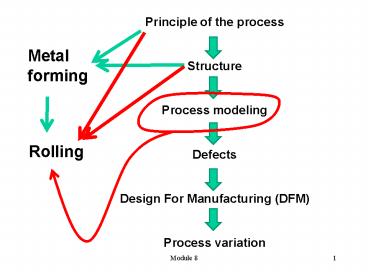Rolling PowerPoint PPT Presentation
1 / 14
Title: Rolling
1
Principle of the process Structure Process
modeling Defects Design For Manufacturing
(DFM) Process variation
Metal forming
Rolling
2
Rolling Process Mechanics Analysis
- Two opposite rolls and a piece of material
flows between them. The shape of rolls can be
designed in a different form to construct a
product with different cross sections.
3
Objectives of mechanics analysis
- Physical phenomenon
- Torque
- Power
- Productivity
4
Physical phenomenon
Spreading Volume before rolling the volume
after rolling
Volume flow rate conservation
5
Vo lt Vr lt Vf
No-slip point
Slipping
Slipping
Work velocity Roll velocity
6
For the rolling process, the true strain is
The average flow stress is the same expression,
i.e.
e
n
k
Y
f
n
1
7
It is the friction between the work and the roll
that drives the workflow between two rolls.
Greater Friction Force
Lesser Friction Force
No-slip point
- The friction force is developed based on
- coefficient of the friction and
- compression force of rolls
8
Condition to roll- Coefficient of the friction
draft, d tf-t0 dmax
9
Condition to roll- Power to drive the roll and
work piece
Roll Force (F)? Integrating unit roll pressure
over roll work contact area
The pressure varies along the contact length
10
Contact length
Contact force
N rotation speed of the roll, rev / min
Power
Power is a function of D. Increase of D leads to
increase of P
11
Condition to roll- Power to drive the roll and
work piece
When the required power (d) is greater than the
supplied power, the rolling of a work piece with
d is not possible.
Therefore, the required power supplied power
will lead to a critical draft d or maximum d.
Criterion 1
Criterion 2 required power supplied power
?
The actual maximum draft for a rolling system is
the smaller one computed from the two criterions
above.
12
Example A 10-in. wide, 1.0-in thick plate is
to be reduced in a single pass in a two-high
rolling mill to a thickness of 0.8 in. The roll
has a radius 20 in., and its speed 50 ft/min.
The work material has a strength coefficient
35.000 lb/in.2 and a strain hardening exponent
0.2. Determine (a) roll force, (b) roll torque,
and (c) power required to accomplish this
operation.
13
Given rolling, t01.0 in., tf0.80 in., w10.0
in., R20 in., vr50 ft/min, flow curve n0.20
and K35,000 lb/in2. Find (a) F, (b) T, (c) HP.
Draft d1.0-0.80.2 in. Contact length L
(200.20)0.5 2.0 in. True strain e ln
(1.0/0.8) ln 1.25 0.223 Average flow stress
f 35,000(0.223)0.20/1.20 21,607 lb/in2
Rolling force F 21,607(10)(2) 423,149 lb
14
Torque T 0.5(432,149)(2.0) 432,149 in-lb.
N (50 ft/min)/(2p20/12) 4.77 rev/min.
Power P2 p (4.77)(432,149)(2) 25,929,940
in-lb/min HP (25,929,940 in-lb/min)/(396,000)
65.5 hp

